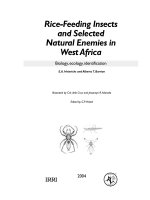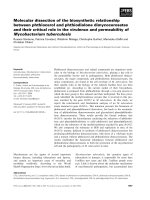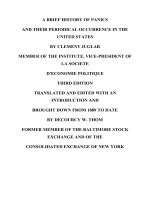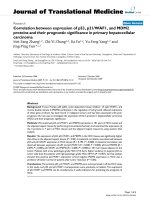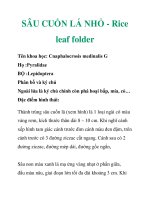Studied on species diversity of rice leaf folder and their natural enemies in north eastern coastal plains of Odisha
Bạn đang xem bản rút gọn của tài liệu. Xem và tải ngay bản đầy đủ của tài liệu tại đây (237.7 KB, 12 trang )
Int.J.Curr.Microbiol.App.Sci (2019) 8(10): 634-645
International Journal of Current Microbiology and Applied Sciences
ISSN: 2319-7706 Volume 8 Number 10 (2019)
Journal homepage:
Original Research Article
/>
Studied on Species Diversity of Rice Leaf Folder and their Natural Enemies
in North Eastern Coastal Plains of Odisha
B. K. Rautaray1*, S. Bhattacharya2, D. Panigrahi3 and S. R. Dash4
1
Krishi Vigyan Kendra, Jagatsinghpur (OUAT), India
Department of Plant Protection, VisvaBharati, India
3
RRTTS (OUAT), Mahisapat, India
4
KrishiVigyan Kendra, Malkangiri, India
2
*Corresponding author
ABSTRACT
Keywords
Diversity of rice,
Leaf folder species,
Predators,
Parasitoids
Article Info
Accepted:
07 September 2019
Available Online:
10 October 2019
In this study the species diversity of rice leaf folder and their natural enemies were
studied in three different blocks of Odisha and three Research stations of Odisha
University Agriculture & Technology, Bhubaneswar(under North Eastern Coastal
plains) during the year 2015 and 2016 at different growth stages of paddy crop on the
basis of morphological characteristics, wing marking, coloration, characters of
pronotum, subdorsal spots on prothorax and size of the larvae as described by Barrion
and Litsinger (1991) etc. The study revealed that three rice leaffolder species were
noticed i.e. Cnaphalocrocis medinalis (Guenée), Marasmia exigua (Bradley) and
Brachimea arotraea (Meyrick) with the predominance of C. medinalis. Among the
Leaffolder species, the highest population of Cnaphalocrocis medinalis (Guenée)
(83.34%), was recorded in each location followed by M. exigua (12.22%) and B.
arotraea (4.43%) was very meager and all the three species were prevalent in all
seasons. The common natural enemy fauna of rice leaf folder C. medinalis comprised
of 10 species predatory arthropods. Out of which the predatory beetles belonging to
the family Carabidae, Cocconellidae were dominant and among different parasitoids
on rice leaf folder, the main spp. observed were, Macrocentrus philippinensis, Cotesia
angustibasis and Goniozus spp, from larvae. The extent of parasitization was more in
kharif season than in rabi. The mean parasitization during kharif 2015&16, rabi
2015&16 was in the order of 21.8 and 17.02 per cent respectively.
Introduction
Rice is one of the major sources of calories for
half of the world’s population. Rice is grown
in more than 100 countries spread across six
continents and in varying agro ecological and
socioeconomic conditions. The eastern india,
consisting of about 60 % of rice growing area
of the country (26.8 mha) possesses about 70
% of rainfed and including about 40 % of low
lying area. Rice is the staple food of Odisha.
During 2015-16, rice was grown over an area
634
Int.J.Curr.Microbiol.App.Sci (2019) 8(10): 634-645
of 40 mha with a total production of 104.32
million tonnes and average yield of 2570 kg/
ha. Among the various biotic constrains to rice
production, insect pests are of prime
importance as the warm humid environment is
conducive to survival and proliferation
(Heong et al., 1995). Among the rice pests,
lepidopterans cause considerable damage to
rice crop and have major importance. Insect
pests damage rice crop at different stages of
crop growth of which leaf feeding insect pests
are of major importance because of their
ability to defoliate or to remove the
chlorophyll content of the leaves leading to
considerable reduction in yield.
Rice leaf folder, Cnaphalocrocis medinalis
(Guen.) was considered as pests of minor
importance have increased in abundance in
late 1980’s and have become major pests in
many parts of India including Odisha. The
yield loss is from 30 to 80 per cent due to leaf
folder epidemic situation (Nanda et al., 1990;
Han et al., 2015). Every unit of increase in
infestation by C. medinalis decreased the yield
by 14 and 1.46 per cent during summer and
wet season, respectively. Currently, leaf
folders Cnaphalocrocis medinalis, C. patnalis,
C. ruralis and C. exigua have attained pest
status on rice (Pandya et al., 1987).
Cnaphalocrocis medinalis, Marasmiaexigua,
M. patnalis and M. ruralis are the four
superficially similar species common in rice
ecosystem in Asia and Philippines. Similar to
those present in the growing rice tracts of
South and Southeast Asia (Khan et al., 1988;
Barrion et al., 1991; Heong, 1993) and in
entire Asia (Gurr et al., 2012). The discovery
of Marasmiapatnalis by Bradley in 1981, first
led to the realization that there was a complex
of leaf folder species. In most of the rice eco
systems studied more than one species of leaf
folder exist in complex, thus the management
of rice leaf folder is a complicated one. Hence,
the identification of leaf folders fauna in
Odisha is needed for the scientists to work out
for an Eco-friendly Integrated Pest
Management, thus it will support the ultimate
beneficiary the farming community for better
control measures of this important pest
species. By keeping this, the present studies
were planned with an objective to study the
species diversity and the natural enemies of
leaf folder in North Eastern Coastal plains of
Odisha (Table 1).
Materials and Methods
Species composition
The study was conducted from four rice
growing blocks (Badachana, Dharmsala,
Bhadrak, Simulia and Baliapal) of three
districts, rice research stations (Ranital,
Baliapal and Badachana) at 15 days intervals
to find out the leaf folder species diversity in
the North Eastern Coastal plains of Odisha.
Leaf folder larvae were collected from leaves
and adults were collected by using sweep net.
The specimens were brought to the laboratory
and examined under binocular microscope.
The diversity of leaf folder species was
expressed in percentage. The leaffolder
species were distinguished based on the larval
and adult characters viz., forewing venation,
coloration, characters of pronotum, subdorsal
spots on prothorax and size of the larvae as
described by Barrion and Litsinger (1991) and
Reissig et al., (1985).
Adult moths of rice leaf folder were collected
by using a light trap from the tillering to
reproductive stages of the crop. The moths
collected were brought to the laboratory and
was examined under binocular microscope.
The different species of Rice leaf folder were
isolated
based
on
wing
venation,
morphological features and size as described
by Barrion and Lit singer (1985), Khan et al.,
(1988). Leaffolders moths were collected from
different blocks and different research stations
of OUAT situated in this region during July –
635
Int.J.Curr.Microbiol.App.Sci (2019) 8(10): 634-645
2015 to Nov.2015 and Jan.2016-june.2016.
The light trap fitted with mercury vapour lamp
(160 W). All collected moths were killed
using ethyl acetate in a killing jar. Moths were
then pinned by spreading the wings in an
insect spreading box for identification. The
individuals belonging to the genera
Cnaphalocrocis, Marasmia and Brachmia
differ basically from each other in forewing
venation and morphological characters. These
morphological
features are used to
differentiate the leaf folder species.
Cnaphalocrocis medinalis (Guenee) moth
were golden yellow with dark brown marking
on the both the wing on mid costa is closely
resembles M. exigua moth were light yellow
with a broad ‘C’ shaped greyish brown band
on terminal and sub terminal area of wing
where as in case of B. arotraea the moths
were yellowish white with whitish streak on
the wings Finally the number of species was
recorded separately and the percentage was
find out.
Natural Enemies of rice leaf folder
Natural Enemies of Leaf Folders were
collected monthly using sweep net.The
observations were made on the important
larval and pupal parasitoids and predators of
leaf folders. And the extent of leaf folder
larval parasitisation was studied during kharif
2015&2016, and summer 2015 &2016 at
KVK, Jajpur. Leaf folder larvae were
collected from the fields during the study
period were transferred into glass tubes of size
15 x 2cm. Leaf pieces of 5cm length taken
from the middle portion of the top leaves of 40
days old plants were provided for feeding,
moistened cotton wool covered with filter
paper cover was used to maintain the turgidity
of leaf pieces. Every 24 hours leaf pieces were
changed till the larvae pupated. The pupae
were observed for the emergence of parasitoid
which were identified under binocular
microscope with help of Entomologist, at
OUAT insect laboratory and percent
parasitisation was find out using following
formula:
Parasitisation percentage (%) =
Number of parasitized larvae
x 100
Total number of larvae collected
Species diversity (%) =
Total no. of individuals of each species
x 100
Total number of individuals
of all species
Results and Discussion
Species Diversity
During (2015&16) survey conducted on
species diversity of rice leaffolder by light trap
and sweep net collected of leaffolder moths in
North Eastern coastal plains districts of
Odisha (Balesore, Bhadrak and jajpur),one
regional research and technology transfer
stations of OUAT and two Krishi
Vigyankendras (Jajpur, Bhadrak) at 15 days
interval and results are presented here under,
three species of rice leaffolders i.e., C.
medinalis, M. exigua and B. arotrea were
encountered at different growth stages (Table
2). Among different districts, C. medinalis
numbers ranged from 79.30 to 88.10 per cent
with an average numbers of 83.34 per cent
was noticed in different districts. The
maximum numbers was found in Dharamsala
(88.1%) followed by Badachana (86.10 %),
Chandabali (82.10 %), where as in Balesore
district (79.30 %) C. medinalis was observed
(Table 2 and Fig. 1). The M. exigua ranged
from 8.40 to 17.20 per cent with an average
numbers of 12.20 per cent was noticed in
different districts. The maximum numbers of
M. exigua was found in Bhadrak (16.80 %)
636
Int.J.Curr.Microbiol.App.Sci (2019) 8(10): 634-645
followed by simulia (17.20 %), Chandabali
(12.5%) and Baliapal (12.1 %) (Table 2 and
Fig. 1). The maximum numbers of B.arotrea
was found in Baliapal (8.0 %) followed by
Badachana (6.20 %), Chandabali (5.40 %) and
Bhadrak (3.6 %).Among the regional research
stations and KVKs the dominant species was
C. medinalis (87.10%) followed by M. exigua
(12.10%) and B. arotrea (5.60%). Padmavathi
et al., (2006), Babyrani et al., (2007) also
confirmed the dominance of C. medinalis in
all rice agro eco systems in South and South
Asia. The similar occurrence of leaf folder
species complex with the dominance of C.
medinalis was reported in Cuttack by
Gunathilagaraj and Gopalan (1986) and
Bhubaneswar by Mukherjee et al., 2008. The
occurrence of C. medinalis was significantly
more than M. exigua and B. arotrea
irrespective of seasons and places.
The present study revealed that of C.
medinalis was the dominant species than M.
exigua and B. arotrea irrespective locations
and places in coastal plains of Odisha.
Mukherjee et al., (2008) was reported that
three species of leaf-folder including, C.
medinalis, M. exigua and B. arotrea were
noticed among which C. medinalis is the
dominant species. Padmavathi et al., (2006)
also confirmed the dominance of C. medinalis
in all rice agro eco systems in South and South
Asia. The occurrence of leaffolder species
complex with the dominance of C. medinalis
was also reported in Cuttack by
Gunathilagaraj and Gopalan (1986) and
Bhubaneswar by Mukherjee et al., (2008). The
occurrence of C. medinalis was significantly
more than M exigua and B. arotrea
irrespective of seasons and places. In general,
during kharif and Summer season harboured
more C. medinalis population than M. exigua
and B. arotrea. Among the leaffolders, C.
medinalis, M. exigua and B. arotrea were
predominantly collected from all surveyed
places and such information was useful during
2015 to relook and identify the efficient
management practices for the management of
all the three species through rescreening of
existing practices. Mathew and Menon (1984)
reported that seven species of rice leaf-folder
viz., C. medinalis, M. exigua (Butler), Ma.
billinialis (Hampson), Ma. patnalis, Ma.
ruralis, Ma. suspicalis (Guenee), Bradina
admixtalis (Walker) and gelechid leaf-folder,
Brachmia arotraea (Meyrick) were found
across the India.
Natural enemies of rice leaf folder
Cnaphalocrocis medinalis is the most
important leaf folder species of rice crop and
is attacked by a large number of natural
enemies. In the present investigation during
the study period on natural enemies complex
(predators and parasitoids) in paddy
ecosystem of north eastern coastal plain areas
of Odisha are represented in the Table 3. The
natural enemies were recorded on the crop
from tillering stage to harvest of crop. A total
of 8 predators were found associated with both
the season rice crops and out of them the
population of spiders out ranked all over
predators. The dominant predators surveyed
were the lady bird beetles, carabids and mirids
were the most important natural enemies.
Besides that dragon flies, damsel flies and
predatory earwigs were also indentified as the
Ariel predators of rice pests (Table 3). Other
important natural enemies of the rice leaf
folder recorded as parasitoid which belongs to
the hymenopterans orders. The recorded
hymenopterans were identified parasitoids
such as, Trichogramma chilonis, T. japonicum
(egg parasitoids), Cotesia angustibasis
(Apanteles),
Macrocentrus
philippinesis
(Ashmead), Goniozustrian gulifer (Kieffer),
Xanthopimpla sp. and A. panteles sp.
(Braconidae) (larval and pupal parasitoid of
leaf folder) (Table 3).
In the present study, predators such as spiders,
dragon and damselflies, mirid bugs,
coccinellids, carabids and cicindellids were
637
Int.J.Curr.Microbiol.App.Sci (2019) 8(10): 634-645
found throughout the crop growing period
with little fluctuation in the three methods.
However, spidres, dragonfly, damselfly and
coccinellids were more during the vegetative
stage of the crop, where asmirids, Staphylinids
and Cerambycidae were more during
reproductive stage of the crop. All the
recorded predators and their population are
known to be directly related to their prey
population. These observations are in
agreement with studies by Parrassapa et al.,
(2017), who reported peak population of
spiders during tilleing stage. The present
finding of domination of spiders among
predators
was
in
accordance
with
Bhattacharya et al., (2006), who reported 26
species of predators of which spiders and
coccinellids were abundant. The predatory
wealth of rice leaffolder was reported by
Gunathilagaraj and Ganesh Kumar (1997) and
revealed that dominant predators belong to
Coleoptera, Arenae, Hymenoptera and
Odonata. Vijay Kumar and Patil (2006) also
confirmed the domination of spiders and
mirids as predators in rice eco system.
Other important natural enemies of the rice
leaf folder C. medinalis recorded at different
stages of crop growth as parasitoid which
belongs to the hymenopterans orders.
The recorded hymenopterans were identified
parasitoids such as, Trichogramma chilonis, T.
japonicum
(egg
parasitoids),
Cotesia
angustibasis
(Apanteles),
Macrocentrus
philippinesis
(Ashmead),
Goniozustrian
gulifer (Kieffer), Xanthopimpla sp. and
Apanteles sp. (Braconidae) (larval and pupal
parasitoid of leaf folder) (Table 4). During the
study period T. japonicum and T. chilonis
were observed as only egg parasitoids. It was
earlier reported in India by Baby rani et al.,
(2007), Behera et al., (2006) and Rubaljot and
Brar (2008), the egg parasitoid Trichogramma
species, the larval parasitoids Cadiochiles
philippinensis, Apanteles spp, Goniozus spp,
Copidosoma psisnacoleiae and Trichoma
cnaphalocrocis Uchida and pupal parasitoid
Xanthopimpla flavolineata Cameron and
larval - pupal parasitoid Brachymeria spp
were prevalent.
Extent of parasitisation
The extent of parasitisation of rice leaf folder
studied from field collected leaffolder larvae
during the both season kharif and summer
crop of 2015and 2016 under north eastern
coastal plains conditions. A comparative study
on the extent of C. medinalis. M. exigua and
B. arotraea revealed that the maximum
parasitisation of 16.66 per cent was recorded
on C. medinalis in the first fort night of
October (Fig. 2).
The parasitisation gradually declined from
mid –October reaching as low as 3.25 per cent
towards fag end of November. In case of M.
exigua the extent of parasitisation varied from
1.84 to 10.95 percent during the above period
with a maximum of 10.95 per cent in the first
fortnight of November. This was due to late
appearance of M. exigua on wet season rice
crop. The B. arotraea recorded 3.10 to 6.92
per cent parasitisation, the maximum being in
the first fort night of October.
The parasitisation per cent gradually increased
from first fort night of September with peak
incidence in the first fortnight of October for
C. medinalis and B. arotraea and then
gradually decreased, thereafter. On the other
hand, parasitisation of M.exigua commenced
from first fortnight of November after which
the population was declined.
638
Int.J.Curr.Microbiol.App.Sci (2019) 8(10): 634-645
Table.1 Characteristics distinguishing larvae of C. medinalis and M exigua and B. arotrea
are listed below (DRR, 1987).
Name of the
insect
Larval
Characteristics
C. medinalis
M exigua
B. arotrea
C. medinalis
M exigua
instar
1st
1st
1st
2nd
2nd
Duration(days)
3.5
4.5
3.5
4.0
3.5
B. arotrea
C. medinalis
M exigua
B. arotrea
2nd
3rd
3rd
3rd
3.2
4.0
4.0
3.2
C. medinalis
M exigua
B. arotrea
4th
4th
4th
4.5
4.5
3.2
C. medinalis
5th
5.2
M exigua
B. arotrea
5th
5th
4.5
5.5
Head black, posterior notch of head capsule prominent
Head black flattened
Head and prothorax black
Head brown, faint brownish mark on protharacic shield
Head light brown, faint brownish mark on prothoracic
shield absent
Head, pro and metathorax black
Brownish patch on either side of pronotum
Head light brown
Head and pro thorax black, meso and metathorax light
black, a specific pattern of lines on the body which are
faintly marked
Dark brown patches on pro thorax prominent
Head light brown
Specific pattern of lines on body prominent and one
lateral and two medium white markings on meso and
metathorax observed
Brownish patches prominent on meso and metathoracic
segments also
Head light brown
Prothoracic shield chitinised.
Table.2 Species diversity of rice leaffolder in North Eastern Coastal plains of Odisha during
2015-16
S.
No
1
2
District
3
4
5
6
7
8
9
Balesore
Jajpur
Jajpur
Bhadrak
Bhadrak
Balesore
Balesore
Mean
Jajpur
Bhadrak
Name of
Block
Badachana
Ranital
Locations
KVK, Jajpur Badachana
RRTTS, Ranital,
Bhadrak
Baliapal
KVK, Balesore
Badachana Badachana
Dharamsala Achyutpur
Bhadrak
Bhadrak
Chandbali
Chandbali
Simulia
Simulia
Baliapal
Baliapal
Total no of
moths Collected
201
188
192
245
195
205
285
155
235
639
C. medinalis M.exigua
(%)
(%)
87.1
10.8
83.2
11.2
84.3
85.4
88.1
80.6
82.1
79.3
80
83.34
12.1
8.4
10
15.8
12.5
17.2
12
12.22
B.arotre
a (%)
2.1
5.6
3.6
6.2
1.9
3.6
5.4
3.5
8
4.43
Int.J.Curr.Microbiol.App.Sci (2019) 8(10): 634-645
Table.3 Natural enemies (predators and parasitoids) of rice leaf folder in north eastern coastal
plains of Odisha
S.No
1
Common name
Wolf spider
2
Lynx spider
3
Orb spider
4
Orb spider
5
jumping spider
6
9
Lady bird
Beetles
Lady bird
Beetles
Lady bird
Beetles
Ground beetle
10
Ground beetle
11
Damselfly
12
Dragon fly
13
14
15
16
Scarlet Skimmer
Earwig
Crickets
Mirid bugs
7
8
17
18
19
20
21
22
23
24
Name
Lycosapseudoannulata
(Boesenberg and Strand)
Oxyopesjananus
(Thorell)
Family
Lycosidae
Order
Araneae
Stage to predates
larvae and adults
Oxyopidae
Araneae
larvae and adults
Argiope catenulate
(Doleschall)
Araneusinustus
(L.koch)
Aranidae
Araneae
larvae and adults
Aranidae
Araneae
larvae and adults
Phidippus sp.
(Koch)
Micraspiscrocea (Mulsant)
Salticidae
Araneae
larvae and adults
Coccinellidae
Coleoptera
egg and adult
Coccinellidae
Coleoptera
egg and adult
Coccinellidae
Coleoptera
egg and adult
Carabidae
Coleoptera
larvae
Carabidae
Coleoptera
larvae
Coenagrionidae
Zygoptera
Adult
Gomphidae
Anisoptera
Adult
Odonata
Dermaptera
Coleoptera
Hemiptera
Adult
Egg and larvae
Egg
Egg
Menochilussexmaculatus
(Fabricius, 1781)
Coccinella
repanda (Thunberg)
Chlaeniusposticalis(Motsch
ulsky)
Ophineanigrofascinata
(Schmidt-Goebel)
Agriocnemispygmaea(Ramb
ur)
Orthetriumsabinasabina
(Drury)
Crocothemisservilia(Drury)
Euborelliastali(Dohrn)
M. vittaticollis(Stål)
C. lividipennis(Reuter)
Trichogrammachilonis
Trichogrammajaponicum
Cotesiaangustibasis(Apanteles)
Macrocentrusphilippinesis
(Ashmead)
Goniozustriangulifer(Kieffer)
Apantelescypris(Nixon)
Brachymeria sp.
Cardiochiles philippinesis
Coenagrionidae
Carcinophoridae
Cerambycidae
Miridae
Parasitoids
Ichneumonidae
Ichneumonidae
Braconidae
Braconidae
Bethylidae
Braconidae
Chalcidae
Braconidae
640
Hymenoptera
Hymenoptera
Hymenoptera
Hymenoptera
Egg parasitoides
Egg parasitoides
Larval parasitoides
Larval parasitoides
Hymenoptera
Hymenoptera
Hymenoptera
Hymenoptera
Larval parasitoides
Larval parasitoides
Pupalparasitoides
Larval parasitoides
Int.J.Curr.Microbiol.App.Sci (2019) 8(10): 634-645
Table.4 Estimation of Natural enemies (Predators) population of Rice Leaf folder C. medinalis
under Coastal rice ecosystem
Sl no
1
2
3
4
5
6
7
8
Name of Predators
Spiders
Lady bird beetle
Carabid beetle
Damselfly
Dragon fly
Earwig
Crickets
Mirid bugs
Predatory population (nos/m2)*
Wet Season 2015
Summer 2016
75 DAT
85DAT
75DAT
85DAT
87.25
52.75
45.25
40.50
115.75
85.50
75.25
68.25
35.25
28. 50
28.25
32.75
9.00
10.00
8.75
5.25
5.15
9.245
2.25
4.25
4.25
3.10
1.25
2.15
7.25
5.25
3.25
7.25
18.25
16.85
24.25
19.40
*Means of 4 quadrates of one square meter each.
Fig.1 Species diversity of rice leaf folder in North Eastern Coastal plains of Odisha (values in %)
641
Int.J.Curr.Microbiol.App.Sci (2019) 8(10): 634-645
Table.5 Extent of Larval parasitisation (%) of rice leaf folder larvae by different species of parasitoids
Sl
no
Extent of Larval parasitisation(%) in different growth
stages during Summer , 2015&2016
Extent of Larval parasitisation (%) at different growth
stages of rice crops during Kharif 2015&16
Fort
C.medinalis M.exigua B.arotraea Total
Fort
C.medinalis M.exigua B.arotraea Total
night/Month
night/Month
1
2
3
4
5
6
Mar-I
Mar-II
Apr.-I
Apr.-II
May-I
Mean
9.06
11.02
10.25
9
4.75
0
0
2.15
11.2
9.23
0
6.83
4.6
4.01
3.01
9.06
17.85
17
24.21
16.99
17.02
642
Sept-I
Sept-II
Oct-I
Oct-II
Nov-I
Nov -II
Mean
10.25
15.95
17.88
14.3
8.15
3.25
0
1.84
3.15
10.13
10.95
6.42
5
4.45
6.92
5.85
3.1
3.13
15.25
22.24
27.95
30.28
22.2
12.8
21.78
Int.J.Curr.Microbiol.App.Sci (2019) 8(10): 634-645
Fig.2 Extent of larval parasitisation (%) in different growth stages of rice crop
In summer season both the year data revealed
that all the rice leaf folder species were
vulnerable to attack by parasites. The extent of
parasitisation by different parasites varied
from 9.06 to 24.21 per cent. Parasitised larvae
were available in the field from first fortnight
of March for C. medinalis and B.arotraea
while from first fortnight of April for
M.exigua. The relative susceptibility of
different species of leaf folders to parasite
attack indicated that the extent of
parasitisation comparatively higher in case of
M.exigua followed by C.medinalis and
B.arotraea.
As regards to the extent parasitisation of
C.medinalis hardly 4.75 to 11.02 per cent
larvae of various instars found by different
parasites species under natural conditions.
Higher parasitisation recorded during second
fortnight of March. Due to late appearance of
leaffolder species M.exigua, no parasitisation
was recorded during March. Only 2.15 per
cent larvae were found to be parasitised in the
first fortnight of April which suddenly
increased to 11.20 per cent in the second
fortnight and parasitisation continued till May.
The extent of larval parasitisation of
B.arotraea varied from 3.01 to 6.83 per cent,
the maximum (6.83%) being in the 2nd
fortnight of March. So the present finding of
extent of parasitisation indicated that
maximum parasitisation was recorded in the
2nd fortnight of March followed by 1st
fortnight of April.
The species complex of rice leaffolder in
different rice growing areas of Odisha was
assessed on the basis of wing markings for
adults. The present study indicated the
occurrence of only three species viz.,
Cnaphalocrocis
medinalis
(Guenee),i
(Bradley) and Brachmiaarotrea (Meyrick).
Among them C. medinalis was the
predominant species with 79.30 to 88.10 per
cent incidence respectively. All the three
species of rice leaf folder were found both the
643
Int.J.Curr.Microbiol.App.Sci (2019) 8(10): 634-645
season in all locations of north eastern coastal
plains of Odisha.
During the present investigation the different
natural enemies that encountered on rice
leaffolder were recorded at different intervals
of crop growth. Among predators the
abundance was in the order of spiders,
cocinellidae, ground beetles, damsel flies,
Dragon fly and earwigs. Among different
parasitoids on rice leaffolder, main species
observed were Trichogramma japonicum and
T. chilonis from eggs, Macrocentrus
philippinensis,
Cotesiaangustibasis
and
Goniosus spp, from larvae, and Brachymeria
from pupae. The extent of parasitisation in
three seasons at different growth stages
indicated that in Kharif season the per cent
was more compared to Rabi. The mean
parasitization during kharif 2015&16 and Rabi
2015&16 was in the order of 21.78 and 17.02
per cent, respectively.
References
Annual Report of Agriculture. Department of
Agriculture and Cooperartion, Odisha.
Area, production and yield of rice in
Odisha. 2015-16,44.
Ane Noor Ul, Hussain Mubashar, 2016.
Diversity of insect pests in major rice
growing areas of the world. Journal of
Entomology and Zoology Studies 2016;
4(1): 36-41
Baby Rani,W., Amutha, R., Muthulakshmi,S.,
Indira K. and Mareeswari, P. 2007.
Diversity of Rice Leaf Folders and
Their Natural Enemies. Research
Journal of Agriculture and Biological
Sciences, 3(5): 394-397
Barrion, A.T., Litsinger, J.A., Medina, E.B.,
Aguda, R.M., Bandong, J.P., Pantua,
P.C., Viajante, V.D., Delta Cruz, C.G.,
Vega, C.R., Sorino, J.S., Jr. Camanag,
E.E., Saxena, R.C., Tryon, E.H and
Shepard, B.M. 1991. The rice
Cnaphalocrocis
medinalis
and
Marasmia (Lepidoptera: Pyralidae)
leaffolder complex in the Philippines:
Taxonomy, bionomics and control,
Philippines. Entomon. 8 (4): 987-1074.
Barrion, AT. and J.A Litsinger. 1985.
Identification of rice leaffolders (LF)
by wing markings. IRRN., 5(4): 24.
CRRI., 1982. Annual Report of 1982. Central
Rice Research Institute, Cuttack,
Orissa, India. pp: 164-168.
DRR. 1987. Characters to distinguish different
species of rice leaf folder. Directorate
of Rice Research, Rajendranagar,
Hyderabad, pp.I-6.
Douresamy, S., M.S. Venugopal, P.
Narayanan and M. Mohanasundaram.
1992. Rice leaffolder species in
Pondicherry. Oryza, 29(4): 39.
Gunathilagaraj, K; Gopalan, M. (1986). Rice
leaffolder (LF) complex in Madurai,
Tamil Nadu, India. International-RiceResearch-Newsletter. 1986; 11(6): 24
Gurr, G.M., D.M.Y. Read, J.L.A. Catindig, J.
Cheng, J. Liu, L.P. Lan and K.L.
Heong. 2012. Parasitoids of the rice
leaffolder Cnaphalocrocis medinalis
(Guenee) and prospects for enhancing
biological control with nectar plants.
Review Article. Agricultural and
Forest Entomology 14: 1-12.
Heong, K.C.,P.S. Teng and K.Moody.1995.
Managing
rice
pests
with
lesschemicals.Geojournal.35:337-349.
Khan ZR, Barrion AT, Litsinger JA, Castilla
NP, Joshi RC. 1988. A bibliography of
rice
leaf
folders
(Lepidoptera:
Pyralidae).
Insect
Science and
Applications.; 9: 129-174.
Mukherjee, S. K. Samalo, A. P. Mishra, P. R.
Dash, A. N. 2008. Effect of
environmental factors on the incidence
of rice leaf-folders in costal Orissa
conditions. Pest Management and
Economic Zoology; 2008. 16(1): 4350.
644
Int.J.Curr.Microbiol.App.Sci (2019) 8(10): 634-645
Nanda, V.K. and R.C. Bisoi, 1990.Bionomics
of rice L7 C.M. Orissa J. Agrl. Res.,
3(2): 130-135.
Pandya, H.V., S.A.H. Singh and M.S. Purohit.
1987. Yield loss caused by leaf folder
damage alone and combined with
yellow stem borer damage. Int. Rice.
Res. Newsl., 12(5): 28.
Parasappa HH, Narasa Reddy G and
Neelakanth. 2017. Rice insect pests
and their natural enemies complex in
different rice ecosystem of Cauvery
command areas of Karnataka. Journal
of Entomology and Zoology Studies,
5(5): 335-338
Reissig, W.H., E.A. Heinrichs, J.A. Litsinger,
K. Moody, L. Fiedler, T.W. Mew and
A.T. Barrion. 1985. Illustrated Guide
to Integrated Pest Management in Rice
in Tropical Asia. Int. Rice Res. Inst.,
P.O. Box. 933, Manila, Philippines,
411- 214.
SainiVarun., Singh Satyapriya, RawalRoomi
and
VenkateshYN.2017.
Species
diversity
and
distribution
of
Cnaphalocrocis and Scirpophaga
(Lepidoptera: Crambidae) species
complex in rice in Tamil Nadu, India.
Journal of Entomology and Zoology
Studies, 5(4): 1308-1313
Senapati B, Panda S.K. 1999. Rice stem
borers in insect pests of cereals and
their management. In: Prakash. A and
J. Rao (Eds.). CRRI Cuttack, Orissa.,
3-18.
Sivaraman, A. and Hari Prasad, Y.2012.
Studies on leaf folder species complex
and their damage potential of popular
rice varieties in Cauvery Delta zone.
International Journal of Current
Research, 4(12): 552-554.
How to cite this article:
Rautaray, B. K., S. Bhattacharya, D. Panigrahi and Dash, S. R. 2019. Studied on Species
Diversity of Rice Leaf Folder and their Natural Enemies in North Eastern Coastal Plains of
Odisha. Int.J.Curr.Microbiol.App.Sci. 8(10): 634-645.
doi: />
645

